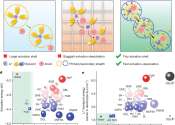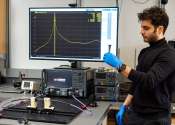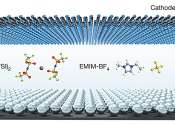MH370 disappearance 10 years on: Can we still find it?
It has been 10 years since Malaysia Airlines passenger flight MH370 disappeared on March 8 2014. To this day it remains one of the biggest aviation mysteries globally.
Mar 5, 2024
0
8
Other

It has been 10 years since Malaysia Airlines passenger flight MH370 disappeared on March 8 2014. To this day it remains one of the biggest aviation mysteries globally.
Mar 5, 2024
0
8
Energy & Green Tech

A team of chemists and engineers affiliated with several institutions has found an electrolyte solution that can be used to reduce the recharging time of lithium-ion batteries while allowing battery capacity to remain comparatively ...
Engineering

In a first-of-its-kind development, UBC Okanagan researchers, in collaboration with Drexel University, have created a new compound that can be used to 3D print telecommunication antennas and other connectivity devices. These ...
Feb 29, 2024
0
45
Energy & Green Tech

Oxygen-free n-Hexane (HEX), the most stable solvent against Li-metal, was successfully introduced into the standard concentration electrolyte to constitute an electrolyte for temperature-immune lithium-metal batteries.
Feb 22, 2024
0
8
Energy & Green Tech

Thermometers are an under-appreciated marvel of human ingenuity built upon an understanding of relatively simple physical principles. Mercury and alcohol thermometers rely on the volume of liquids growing or shrinking in ...
Feb 22, 2024
0
21
Electronics & Semiconductors

Researchers from Fujitsu and QuTech have developed new and ultra-cold electronic circuits to control diamond-based quantum bits. As a result of their joint research project, it becomes possible to build larger quantum computers, ...
Feb 21, 2024
0
1
Energy & Green Tech

A multi-institutional team of Chinese engineers has developed a proof-of-concept calcium-based battery that withstands 700 charge cycles at room temperature. In their paper published in the journal Nature, the group describes ...
Engineering

Extensive greenery coverage on building rooftops could significantly reduce temperatures at the city scale and decrease energy costs, according to a new study.
Feb 13, 2024
0
242
Energy & Green Tech

An international team of scientists has made a new discovery that may help to unlock the microscopic mystery of high-temperature superconductivity and address the world's energy problems.
Feb 12, 2024
0
40
Consumer & Gadgets

When a group of California researchers started a COVID-19 study in 2020 using fitness tracking rings, they didn't know they would make a leap forward for an entirely different condition.
Feb 12, 2024
1
1
In physics, temperature is a physical property of a system that underlies the common notions of hot and cold; something that feels hotter generally has the higher temperature. Temperature is one of the principal parameters of thermodynamics. If no heat flow occurs between two objects, the objects have the same temperature; otherwise heat flows from the hotter object to the colder object. This is the content of the zeroth law of thermodynamics. On the microscopic scale, temperature can be defined as the average energy in each degree of freedom in the particles in a system. Because temperature is a statistical property, a system must contain a few particles for the question as to its temperature to make any sense. For a solid, this energy is found in the vibrations of its atoms about their equilibrium positions. In an ideal monatomic gas, energy is found in the translational motions of the particles; with molecular gases, vibrational and rotational motions also provide thermodynamic degrees of freedom.
Temperature is measured with thermometers that may be calibrated to a variety of temperature scales. In most of the world (except for Belize, Myanmar, Liberia and the United States), the Celsius scale is used for most temperature measuring purposes. The entire scientific world (these countries included) measures temperature using the Celsius scale and thermodynamic temperature using the Kelvin scale, which is just the Celsius scale shifted downwards so that 0 K= −273.15 °C, or absolute zero. Many engineering fields in the U.S., notably high-tech and US federal specifications (civil and military), also use the kelvin and degrees Celsius scales. Other engineering fields in the U.S. also rely upon the Rankine scale (a shifted Fahrenheit scale) when working in thermodynamic-related disciplines such as combustion.
This text uses material from Wikipedia, licensed under CC BY-SA